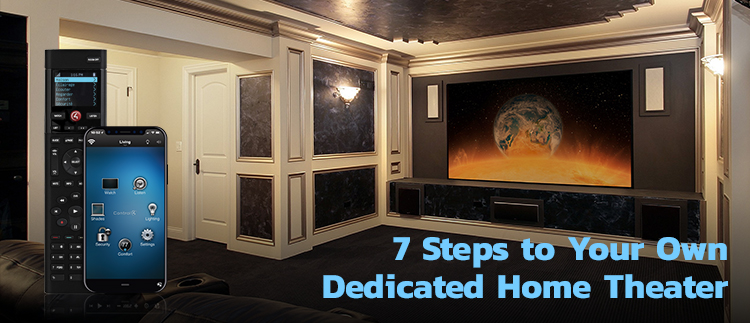7 Steps to Your Own Dedicated Home Theater

Home entertainment these days comes in all shapes and (screen) sizes. From your favorite weekly reality shows on the family room 70” 4K TV to streaming Netflix on your mobile device – it seems there are endless options to get your entertainment fix.
But what if there was more – something better? For those sports fans out there, what if there was a way to watch the big game with lifesize in-your-face action as if you were actually there? Or to immerse yourself into a true cinema-like audio visual experience watching the latest action or drama movie?
A dedicated home theater does just this. It brings home entertainment to that next level whether it’s a top of the line million dollar new construction creation or an existing room transformed on a modest budget. Here are 7 steps to consider in the process to create your own dedicated home theater.
Step 1 – Design Your Dream Room
This is where you put your thoughts to paper. Where you should also be factoring budget into the equation, weighing the pros and cons of each component – ultimately giving you a realistic gameplan. While a home theater can be a do-it-yourself project, it’s recommended to work with an AV expert like Hoppen Home Systems to ensure no step is missed along the way. If it’s a new construction project, it’s important to plan with the builder from the very beginning – just like you will with the electrician, plumber, etc. If the plan is to remodel an existing room like an attic, basement or extra bedroom – determine the general layout and what structural adjustments may be necessary before doing anything else.

Step 2 – Pre-wire for Centralized Equipment
A proper home theater installation should be clean with no wires showing. It should also also be carefully planned to have all those hidden wires come together in one centralized location. This not only maintains that clean design but it also allows for smoother integration of the various components that work together like the speakers, receiver, projector, lighting, and more.

Step 3 – Choose Right Projector and Projection Screen
One valid concern when building a dedicated home theater is to have a sharp high resolution picture. The last thing you want to set everything up only to have a fuzzy or grainy picture on the screen. The two pieces that come together here are the projector and the projection screen. Several years ago, the screen size could only get so big before the resolution of the project couldn’t keep up. Thankfully, it seems every year technology has been has been pushing the limits of size and resolution. For example, with the latest Sony 4K SXRD Home Cinema Projector, you can experience lifelike clarity on screen sizes well over 150 inches (even up to 200-300” on certain models). It’s also important to keep in mind other factors like how the natural lighting of the room can impact decision of lumens (brightness) and the dimensions of the room can dictate the appropriate position and distance from projector to screen.

Step 4 – Seating: Comfort vs. Function
Whether you’re on the edge of your seat enjoying the latest action movie or snuggled up to watch romantic comedy – your seating is very much part of the experience. And this is the part where you can do one better than the local cinema. From plush leather recliners to more casual sofa arrangements to high-tech seating with integrated vibration – it’s important to strike the right balance between comfort and function. (and budget – as with anything, options are endless with seating)

Step 5 – Acoustics and Speaker Selection
There’s the video and then there’s the audio. In a dedicated home theater, you don’t want to skimp on the audio. A smaller room can do just fine with a decent 5.1 Surround Sound System, while larger should go with a 7.1 (or even a 7.2 if your neighbors don’t mind the rumble from that extra subwoofer). It’s more than just the speakers though. Your receiver/amplifier equipment needs to be quality and powerful enough. You should also be thinking about the “acoustics” in the room. For optimal acoustic performance, at least 50% of the room should be covered in absorption material. (this can be carpet or specially designed acoustic panels)

Step 6 – Personalized Theme Decor
The “finishing touch” should be considered at the very beginning. You’ve probably seen pictures of them by now – the Star Wars theme or the flashback to the Art Deco style theater. Choosing a theme for the room can be fun and will be what makes your room “your room”. Custom cabinetry to wall decor to special carpeting – the sky is the limit when it comes to how much you want to put into the theme of the home theater. Just remember to be mindful not to impact the actual functionality and purpose of the room.

Step 7 – Program Media Controls
There’s nothing better than to sit down in that comfy new theater chair and simply click “play”. A well thought out dedicated home theater typically has some level of automated controls programmed to make the experience as seamless as possible. Relying very much on the #2 Centralized Pre-wiring – an automation system like Control4 can automate the entire audio video sequence as well as tie in the perfect lighting to set the mood. A pre-programmed remote control can also be a good option to simplify the steps for even the most non-techy family member.

________________________________
A dedicated home theater is a real treat. If you’re thinking about building or remodeling to make this dream come true – the expert team at Hoppen Home Systems would love to help.
Contact us today for a free consultation or stop by our new showroom.
